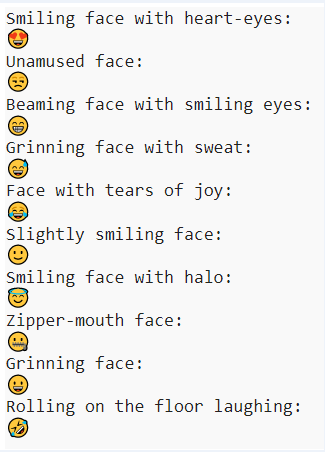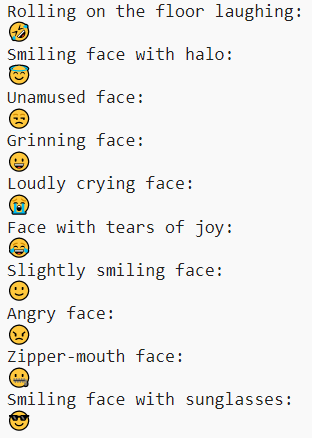Python: Print Emojis using unicode Characters or CLDR (Common Locale Data Repository ) short names
Print Emojis with Unicode
Write a Python program to print Emojis using Unicode characters or CLDR (Common Locale Data Repository) short names.
Note: The Common Locale Data Repository Project, often abbreviated as CLDR, is a project of the Unicode Consortium to provide locale data in XML format for use in computer applications. CLDR contains locale-specific information that an operating system will typically provide to applications.
Using Unicode characters:
Sample Solution-1:
Python Code:
# Printing a smiling face with heart-eyes using Unicode escape sequence.
print("Smiling face with heart-eyes:")
print("\U0001F60D")
# Printing an unamused face using Unicode escape sequence.
print("Unamused face:")
print("\U0001F612")
# Printing a beaming face with smiling eyes using Unicode escape sequence.
print("Beaming face with smiling eyes:")
print("\U0001F601")
# Printing a grinning face with sweat using Unicode escape sequence.
print("Grinning face with sweat:")
print("\U0001F605")
# Printing a face with tears of joy using Unicode escape sequence.
print("Face with tears of joy:")
print("\U0001F602")
# Printing a slightly smiling face using Unicode escape sequence.
print("Slightly smiling face:")
print("\U0001F642")
# Printing a smiling face with halo using Unicode escape sequence.
print("Smiling face with halo:")
print("\U0001F607")
# Printing a zipper-mouth face using Unicode escape sequence.
print("Zipper-mouth face:")
print("\U0001F910")
# Printing a grinning face using Unicode escape sequence.
print("Grinning face:")
print("\U0001F600")
# Printing a rolling on the floor laughing face using Unicode escape sequence.
print("Rolling on the floor laughing:")
print("\U0001F923")
Sample Output:
Using CLDR Short Names:
Sample Solution-2:
Python Code:
# Printing a rolling on the floor laughing face using Unicode character name.
print("Rolling on the floor laughing:")
print("\N{rolling on the floor laughing}")
# Printing a smiling face with halo using Unicode character name.
print("Smiling face with halo:")
print("\N{smiling face with halo}")
# Printing an unamused face using Unicode character name.
print("Unamused face:")
print("\N{unamused face}")
# Printing a grinning face using Unicode character name.
print("Grinning face:")
print("\N{grinning face}")
# Printing a loudly crying face using Unicode character name.
print("Loudly crying face:")
print("\N{loudly crying face}")
# Printing a face with tears of joy using Unicode character name.
print("Face with tears of joy:")
print("\N{face with tears of joy}")
# Printing a slightly smiling face using Unicode character name.
print("Slightly smiling face:")
print("\N{slightly smiling face}")
# Printing an angry face using Unicode character name.
print("Angry face:")
print("\N{angry face}")
# Printing a zipper-mouth face using Unicode character name.
print("Zipper-mouth face:")
print("\N{zipper-mouth face}")
# Printing a smiling face with sunglasses using Unicode character name.
print("Smiling face with sunglasses:")
print("\N{smiling face with sunglasses}")
Sample Output:
For more Practice: Solve these Related Problems:
- Write a Python program to print a list of emojis using their Unicode code points.
- Write a Python program to display emoji characters by converting Unicode escape sequences to symbols.
- Write a Python program to output emojis using both Unicode characters and CLDR short names from a predefined list.
- Write a Python program to iterate through a list of Unicode emoji codes and print the corresponding emoji characters.
Go to:
Previous: Write a Python program to check if every consecutive sequence of zeroes is followed by a consecutive sequence of ones of same length in a given string. Return True/False.
Next: Write a Python program to convert integer to string.
Python Code Editor:
Have another way to solve this solution? Contribute your code (and comments) through Disqus.
What is the difficulty level of this exercise?
Test your Programming skills with w3resource's quiz.


